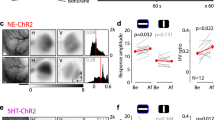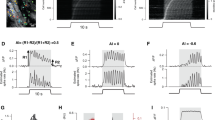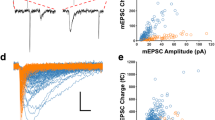Abstract
The fine-tuning of circuits in sensory cortex requires sensory experience during an early critical period. Visual deprivation during the critical period has catastrophic effects on visual function, including loss of visual responsiveness to the deprived eye1,2,3, reduced visual acuity4, and loss of tuning to many stimulus characteristics2,5. These changes occur faster than the remodelling of thalamocortical axons6, but the intracortical plasticity mechanisms that underlie them are incompletely understood. Long-term depression of excitatory intracortical synapses has been proposed as a general candidate mechanism for the loss of cortical responsiveness after visual deprivation7,8. Alternatively (or in addition), the decreased ability of the deprived eye to activate cortical neurons could be due to enhanced intracortical inhibition9,10. Here we show that visual deprivation leaves excitatory connections in layer 4 (the primary input layer to cortex) unaffected, but markedly potentiates inhibitory feedback between fast-spiking basket cells (FS cells) and star pyramidal neurons (star pyramids). Further, a previously undescribed form of long-term potentiation of inhibition (LTPi) could be induced at synapses from FS cells to star pyramids, and was occluded by previous visual deprivation. These data suggest that potentiation of inhibition is a major cellular mechanism underlying the deprivation-induced degradation of visual function, and that this form of LTPi is important in fine-tuning cortical circuitry in response to visual experience.
This is a preview of subscription content, access via your institution
Access options
Subscribe to this journal
Receive 51 print issues and online access
$199.00 per year
only $3.90 per issue
Buy this article
- Purchase on SpringerLink
- Instant access to full article PDF
Prices may be subject to local taxes which are calculated during checkout




Similar content being viewed by others
References
Wiesel, T. N. & Hubel, D. H. Single cell responses in striate cortex of kittens deprived of vision in one eye. J. Neurophysiol. 26, 1003–1017 (1963)
Fagiolini, M., Pizzorusso, T., Berardi, N., Domenici, L. & Maffei, L. Functional postnatal development of the rat primary visual cortex and the role of visual experience: dark rearing and monocular deprivation. Vision Res. 34, 709–720 (1994)
Frenkel, M. Y. & Bear, M. F. How monocular deprivation shifts ocular dominance in visual cortex of young mice. Neuron 44, 917–923 (2004)
Prusky, G. T., West, P. W. & Douglas, R. M. Experience-dependent plasticity of visual acuity in rats. Eur. J. Neurosci. 116, 135–140 (2000)
White, L. E., Coppola, D. M. & Fitzpatrick, D. The contribution of sensory experience to the maturation of orientation selectivity in ferret visual cortex. Nature 411, 1049–1052 (2001)
Antonini, A. & Stryker, M. P. Plasticity of geniculocortical afferents following brief or prolonged monocular occlusion in the cat. J. Comp. Neurol. 369, 64–82 (1996)
Rittenhouse, C. D., Shouval, H. Z., Paradiso, M. A. & Bear, M. F. Monocular deprivation induces homosynaptic long-term depression in visual cortex. Nature 397, 347–350 (1999)
Kirkwood, A., Rioult, M. C. & Bear, M. F. Experience-dependent modification of synaptic plasticity in visual cortex. Nature 381, 526–528 (1996)
Duffy, F. H., Burchfield, J. L. & Conway, J. L. Bicuculline reversal of deprivation ambylopia in the cat. Nature 260, 256–257 (1976)
Sillito, A. M., Kemp, J. A. & Blakemore, C. The role of GABAergic inhibition in the cortical effects of monocular deprivation. Nature 291, 318–320 (1981)
Rauschecker, J. P. Cortical map plasticity in animals and humans. Prog. Brain Res. 138, 73–88 (2002)
Barrett, B. T., Bradley, A. & McGraw, P. V. Understanding the neural basis of amblyopia. Neuroscientist 10, 106–117 (2004)
Maffei, A., Nelson, S. B. & Turrigiano, G. G. Selective reconfiguration of layer 4 visual cortical circuitry by visual deprivation. Nature Neurosci. 7, 1353–1359 (2004)
Egger, V., Feldmeyer, D. & Sakmann, B. Coincidence detection and changes of synaptic efficacy in spiny stellate neurons in rat barrel cortex. Nature Neurosci. 2, 1098–1105 (1999)
Desai, N. S., Cudmore, R. H., Nelson, S. B. & Turrigiano, G. G. Critical periods for experience-dependent synaptic scaling in visual cortex. Nature Neurosci. 5, 783–789 (2002)
Hensch, T. K. Critical period plasticity in local cortical circuits. Nature Rev. Neurosci. 6, 877–888 (2005)
Thomson, A. M., Bannister, A. P., Mercer, A. & Morris, O. T. Target and temporal pattern selection at neocortical synapses. Phil. Trans. R. Soc. Lond. B 357, 1781–1791 (2002)
Gaiarsa, J. L., Caillard, O. & Ben-Ari, Y. Long-term plasticity at GABAergic and glycinergic synapses: mechanisms and functional significance. Trends Neurosci. 25, 564–570 (2002)
Woodin, M. A., Ganguly, K. & Poo, M. M. Coincident pre- and postsynaptic activity modifies GABAergic synapses by postsynaptic changes in Cl- transporter activity. Neuron 39, 807–820 (2003)
Holmgren, C. D. & Zilberter, Y. Coincident spiking activity induces long-term changes in inhibition of neocortical pyramidal cells. J. Neurosci. 21, 8270–8277 (2001)
Simons, D. J. Response properties of vibrissa units in rat S1 somatosensory neocortex. J. Neurophysiol. 41, 798–820 (1978)
Contreras, D. & Palmer, L. Response to contrast of electrophysiologically defined cell classes in primary visual cortex. J. Neurosci. 23, 6936–6945 (2003)
Buzas, P., Eysel, U. T., Adorjan, P. & Kisvarday, Z. F. Axonal topography of cortical basket cells in relation to orientation, direction and ocular dominance maps. J. Comp. Neurol. 473, 259–285 (2001)
Gibson, J. R., Bierlein, M. & Connors, B. W. A network of electrically coupled inhibitory neurons in neocortex. Nature 402, 75–79 (1999)
Barlow, H. B. & Levick, W. R. The mechanism of directionally selective units in rabbits' retina. J. Physiol. 178, 477–504 (1965)
Schoppa, N. E. & Urban, N. N. Dendritic processing within olfactory bulb circuits. Trends Neurosci. 26, 501–506 (2003)
Kayser, A. S. & Miller, K. D. Opponent inhibition: a developmental model of layer 4 of the neocortical circuit. Neuron 33, 131–142 (2002)
Hirsch, J. A. et al. Functionally distinct inhibitory neurons at the first stage of visual cortical processing. Nature Neurosci. 6, 1300–1308 (2003)
Jin, X., Huguenard, J. R. & Prince, D. A. Impaired Cl- extrusion in layer V pyramidal neurons of chronically injured epileptogenic neocortex. J. Neurophysiol. 93, 2117–2126 (2005)
Kilman, V., van Rossum, M. C. & Turrigiano, G. G. Activity deprivation reduces miniature IPSC amplitude by decreasing the number of postsynaptic GABAA receptors clustered at neocortical synapses. J. Neurosci. 22, 1328–1337 (2002)
Acknowledgements
We thank R. Pavlyuk for help with histology, and A. Fontanini for help with software and for discussions. This study was supported by the National Institutes of Health.
Author information
Authors and Affiliations
Corresponding author
Ethics declarations
Competing interests
Reprints and permissions information is available at www.nature.com/reprints. The authors declare no competing financial interests.
Supplementary information
Supplementary Figures
This file contains Supplementary Figures 1–5 with their legends. (DOC 181 kb)
Rights and permissions
About this article
Cite this article
Maffei, A., Nataraj, K., Nelson, S. et al. Potentiation of cortical inhibition by visual deprivation. Nature 443, 81–84 (2006). https://doi.org/10.1038/nature05079
Received:
Accepted:
Published:
Issue Date:
DOI: https://doi.org/10.1038/nature05079



